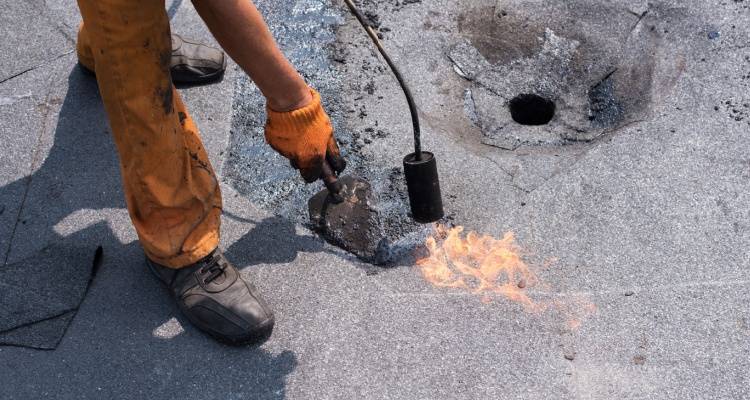Flat Rubber Roof Repair Near Me takes center stage in this comprehensive guide, offering valuable insights into the importance of maintenance, signs of damage, professional services, and DIY tips. Whether you’re a homeowner or business owner, this article equips you with the knowledge needed to ensure your flat rubber roof remains in top condition.
Importance of Flat Rubber Roof Repair
Maintaining a flat rubber roof is crucial for the longevity of the building as it acts as the first line of defense against harsh weather conditions and water damage. Neglecting repairs can lead to more costly damage in the future, such as leaks, mold growth, and structural issues. Regular inspections and timely repairs are essential to ensure the integrity and durability of flat rubber roofs.
Benefits of Regular Inspections
- Early detection of potential issues
- Prevention of costly repairs
- Extension of the roof’s lifespan
Signs of Flat Rubber Roof Damage
Flat rubber roofs are prone to damage over time, especially due to exposure to harsh weather conditions. It is important to be able to identify the common signs of damage to ensure timely repairs and prevent further issues.
Weather conditions play a significant role in the wear and tear of a rubber roof. Extreme heat can cause the rubber material to expand and contract, leading to cracks and leaks. On the other hand, cold temperatures can make the rubber brittle and more susceptible to damage. Heavy rainfall, snow, and ice can also cause pooling water and drainage issues, further compromising the integrity of the roof.
It is crucial to address small issues on a flat rubber roof promptly before they escalate into major problems. Ignoring minor damage can result in more extensive and costly repairs down the line. By keeping an eye out for signs of damage and addressing them promptly, you can prolong the lifespan of your flat rubber roof and ensure its continued protection of your property.
Professional Flat Rubber Roof Repair Services
When it comes to repairing a flat rubber roof, hiring a professional repair service can save you time, money, and ensure the job is done correctly. These services typically include a range of tasks to address any issues with your roof.
Overview of Professional Flat Rubber Roof Repair Services
- Thorough inspection of the roof to identify the extent of damage
- Repair or replacement of damaged sections of the rubber membrane
- Sealing any leaks or cracks to prevent water infiltration
- Applying protective coatings to extend the lifespan of the roof
- Ensuring proper drainage to prevent water pooling
Advantages of Hiring a Professional Repair Service
- Expertise: Professional contractors have the knowledge and experience to effectively repair flat rubber roofs.
- Quality Materials: They use high-quality materials that are durable and long-lasting.
- Time-Saving: Professionals can complete the repair job efficiently, saving you time and hassle.
- Warranty: Many professional repair services offer warranties on their work, providing added peace of mind.
Tips for Finding Reputable Flat Rubber Roof Repair Contractors
- Ask for Recommendations: Seek referrals from friends, family, or neighbors who have had roof repairs done.
- Check Reviews: Look for online reviews and ratings of local roofing contractors to gauge their reputation.
- Verify Credentials: Ensure the contractor is licensed, insured, and has experience working with flat rubber roofs.
- Get Multiple Quotes: Obtain estimates from several contractors to compare prices and services offered.
DIY Flat Rubber Roof Repair Tips
When it comes to repairing your flat rubber roof, there are some DIY tips to keep in mind to ensure the job is done safely and effectively. By following proper safety precautions, using the right tools and materials, and understanding the step-by-step process, homeowners can tackle simple repairs on their own.
Safety Precautions
Before attempting any DIY repairs on a flat rubber roof, it is crucial to prioritize safety. Here are some safety precautions to take:
- Always work with a partner or have someone nearby in case of emergencies.
- Use proper safety gear such as gloves, goggles, and non-slip footwear.
- Avoid working on the roof during wet or windy conditions to prevent accidents.
- Be cautious of power lines and other potential hazards around the roof area.
Tools and Materials
To perform basic flat rubber roof repairs, you will need the following common tools and materials:
- Utility knife or roofing scissors for cutting materials.
- Clean rags or towels to remove debris and excess moisture.
- Rubber roof patch kits or sealants specifically designed for flat rubber roofs.
- Roofing adhesive to secure patches in place.
Step-by-Step Process
Here is a simple step-by-step guide for DIY flat rubber roof repairs:
- Clean the repair area thoroughly to remove dirt, debris, and any loose materials.
- Cut a patch from the rubber roof patch kit to cover the damaged area, ensuring it is slightly larger than the damaged section.
- Apply roofing adhesive around the edges of the patch and press it firmly onto the damaged area.
- Smooth out any air bubbles or wrinkles in the patch to ensure a secure seal.
- Allow the adhesive to dry completely before inspecting the repair for any leaks or additional damage.
Ultimate Conclusion
In conclusion, Flat Rubber Roof Repair Near Me is not just a task but a responsibility to protect your property. By staying proactive and informed, you can address issues promptly and avoid costly damages in the long run. Trust the experts or utilize the DIY tips provided to keep your flat rubber roof in optimal shape.
